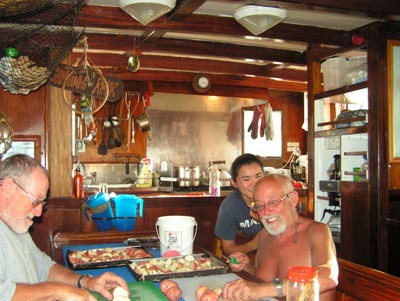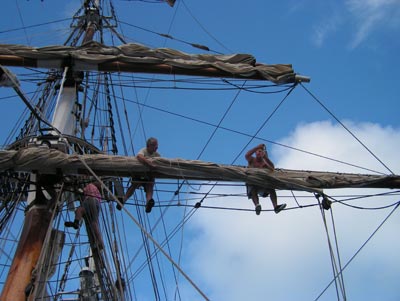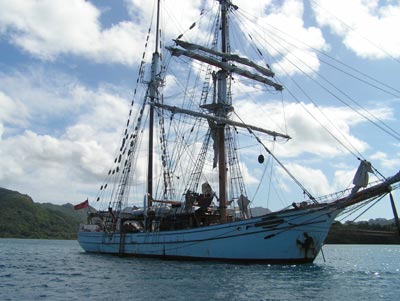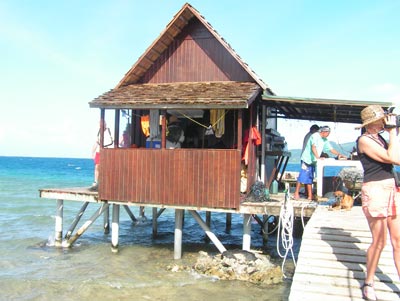Sailing the Society Islands by tall-masted ship
by Brita Bishop, Dallas, TX
To sail French Polynesia — and to do so on a square-rigged, tall-masted brigantine — seemed the height of romance. So in July ’07 I signed on for a cruise on the Søren Larsen, becoming a member of the Voyage Crew. Sixteen of us were joined by the permanent crew of 10, all of them laid-back, friendly and patient.
Getting acquainted
The Søren Larsen (www.sorenlarsen.com) circumnavigates the South Pacific out of New Zealand every year. Passengers can sign on for any length of trip — from 12 days of island hopping, which I did on this trip, to 51 days of open-ocean sailing.
After spending the night at Tahiti’s Sheraton, where the cheaper, garden-view rooms have a beautiful view of the island of Moorea at sunrise, I joined my fellow passengers on the Søren Larsen. We had lunch on deck, then motored to Tahiti’s Point Venus.
While motoring, the captain welcomed us and gave us a few ground rules. We would stand watch while sailing — four hours on, eight hours off — and no one could drink before watches. Since we seldom sailed at night, watch duty was not onerous.
The purser then taught us one of the more important lessons: how to pump water into and out of the heads (toilets). Her rules were short showers, no showers before 10 a.m. and shirts in the saloon when eating dinner. The penalty for not following these rules? The “beer fine”: you treated whoever caught you breaking a rule to a beer.
Learning the ropes
After anchoring at Point Venus, most of us had a long swim in the deep blue water. The first mate then assigned lifeboat stations and gave a safety lecture. With four 20-person lifeboats, we obviously would not have a Titanic situation.
The brave members of our crew practiced “going aloft.” The trickiest part was climbing around a small platform located halfway up the mast. I had to hook my safety harness onto some ropes, but, as the safety harness went only around my waist, the thought of dangling by my waist in case I slipped did not appeal to me. I also hadn’t counted on the continual swaying of the mast.
My group’s watch was the next morning. As we didn’t sail until 10 a.m., we had two hours to “learn the ropes,” literally, and get watch instructions. We were told to rotate bow watch every half hour, ring the bell every half hour, do a safety round once an hour, and sometime during the watch check the bilge pump and the temperature of the engine (if it was running) and fill in the log with wind, wave and weather conditions.
Soon it was all hands on deck, and everyone worked the numerous ropes to raise the sails. How exciting it was to see the Søren Larsen under sail!
Setting sail
By early afternoon we sailed into Moorea’s Cook’s Bay and took rubber dinghies ashore. The next morning some of the more energetic of the group went for a hike up a mountain while the rest of us swam and leisurely explored the island, stopping only for some tropical drinks.
In the afternoon we were off to Taha’a, called Vanilla Island. We sailed through the night, and during our watch I took my turn at the helm. I tried steering by the stars, which was a bit difficult as they seemed to bob up and down with the movement of the ship. We had quite a wind and made good time.
On Taha’a we hiked to a vanilla farm, saw a pearl farm and then cooled off with some snorkeling. After anchoring overnight, we set sail for Bora Bora.
With little to do while on watch, I volunteered for brass polishing. The young deckhand looked at my work and, finding several places I missed, said, “Do you call that brass polishing?”
I muttered, “Slave driver,” as the captain, at the helm, watched in amusement. “I can’t believe I’m paying to do this!” I said.
Bora Bora
Bora Bora, which claims to be the most beautiful island in the world, is surrounded by fringing reefs. The island offers a mind-boggling number of activities. I opted for a leisurely walk around, then went snorkeling off one of our dinghies several times. I joined a tour of the island the following day.
Seated in the back of 4-wheel-drive trucks, we drove up three mountains on steep and muddy tracks. The view from the top, with the fantastic colors of the reef, was one for postcards.
Many of us had dinner at the famous Bloody Mary’s Restaurant, where diners choose fish from a table at the entrance. The atmosphere was great, and it was a nice change from eating on the ship.
Those who ordered the grilled fish pronounced their meals great. I had one of the island specialties, fish with vanilla sauce. The fish was overcooked and the vanilla sauce tasted like vanilla pudding — not a happy combination. The meal cost $65 including wine and tip.
On to Raiatea
That night we sailed toward Raiatea, once the center of worship for the god Oro. A short walk from the dinghy landing took us to the numerous marae, large, square, flat areas paved with volcanic stone and decorated with numerous stele. The offering tables once held pigs and, sometimes, humans.
On Sunday morning, two crew members went to inquire what time church services started. “Whenever the bell rings” was the answer.
To play it safe, several of us went ashore around 9 a.m. After three ringings of the bell, women wearing flowery dresses and big-brimmed hats decorated with flowers streamed into the church with their families.
The singing of les hymnes (in Polynesian) gave me goose bumps. Generally, one woman would start and others would join in loudly.
The sermon was first in French and then in Polynesian. Afterward a dozen parishioners kissed us each on both cheeks.
Island exploration
After lunch we sailed toward Huahine, made up of two main islands. The rain came down, and those of us not on watch crowded around the captain on the sheltered part of the deck to hear his lecture on navigation. That night we enjoyed singing sea chanties.
While snorkeling the next day we saw a large number of outrigger canoes coming from the island. A race was on. All through July there are numerous celebrations on the islands.
I wanted to see both Huahine Nui and Huahine Iti, so I took a tour of the islands with a chatty expat arranged by the ship’s purser at a cost of around $50.
Huahine Nui is the least touristy island, and Huahine Iti is primarily agricultural. We stopped at a number of marae and visited a white coral beach and a vanilla grower’s house. We also saw Polynesia’s answer to ice fishing: huts on stone piers, which anyone can use for fishing.
A fond farewell
In the morning, the wind was against us. The captain had the main square sails lowered and the engineer started the engines.
With so little sail work, the officers apparently decided it was time for a fire drill. All of a sudden the cook yelled, “Fire in the galley!” The two deckhands donned fire suits, and others got out the hose and started pumping seawater while two crew members covered the galley windows. The purser took attendance at the lifeboat stations. We all had paid attention and were lined up correctly.
We arrived at Moorea around lunchtime and this time spent the night in Opunohu Bay, where Captain Cook had actually anchored.
We celebrated with a farewell party. The purser pulled out all sorts of odd costumes and everyone managed to find something in their size. We sang and talked and got a little sad at having to soon leave what had become our home over the previous 11 days.
As we sailed into Tahiti’s harbor, many people on shore pulled out their cameras. The officers, all in crisp white shirts with epaulettes, made for a neat picture.
After saying farewell, I stopped by the tourist office to reserve a tour of Tahiti by van, then wandered around Papeete until the tour started. Afterward I had a chance to eat at one of the roulettes, the portable carts that are set up each night at the harbor.
What was wonderful about the trip? Being one of the few people to have sailed one of these ships; the sight of the ship in full sail; learning about sailing; the great crew; the beauty of the islands, and the instant camaraderie — important to me as a single person visiting islands full of honeymooners.
I purchased the trip through Adventure Center (Emeryville, CA; 800/228-8747, www.adventurecenter.com) at a cost of $2,400. I also paid $1,070 for my round-trip flight on Air Tahiti Nui from Los Angeles (through Travelocity) and $200 for one night at the Sheraton in Tahiti.





